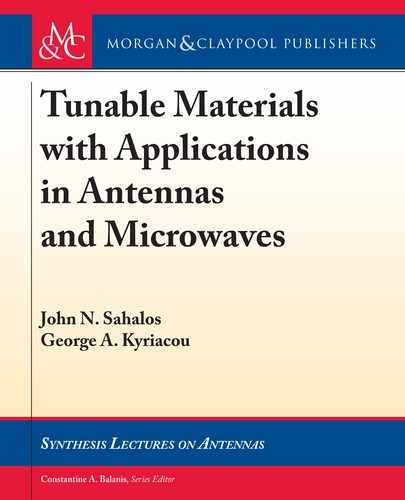
156 3. FINITE FERRITE SAMPLES
3.24.10 MAGNETOSTATIC MODES OF A FINITE WIDTH SLAB
A point of practical interest is the investigation of magnetostatic modes characteristics when
the ferrite slab (film) has a finite width .w/. ese modes have been studied by O’Keefe and
Patterson [49], and presented also by Ishak [50]. Herein, it can be relatively easy included in
the above analysis. Simply, a slight modification of the eigenfunctions given in Eqs. (3.232) is
needed. First, we must decide which of the two infinite slab dimensions in Oy or Oz-directions will
be restricted to a finite width w. is is directly related to the type of magnetostatic waves to
be sought, since for a Oz-biased slab, volume modes are primarily propagating in the Oz-direction,
while surface modes are primarily directed along Oy-direction. Let us study both in turn.
3.24.11 SURFACE MODES OF FINITE WIDTH SLAB .w=2 z w=2/
Propagation along an infinite Oy-direction as e
jk
y
y
will be retained. In addition, a standing wave
should be considered along the finite z-dimension. For this purpose, let us replace the corre-
sponding eigenfunctions in (3.232) as:
e
jk
z
z
! h.z/ D A
z
e
jk
z
z
C A
z
e
Cjk
z
z
: (3.246)
All the previous boundary conditions applied on f .x/ eigenfunctions should be preserved
as they are, since h.z/ appears the same in all different x-ranges. However, new boundary condi-
tions should be imposed at the two edges z D ˙w=2, that is, at the new ferrite (or material)—air
interfaces. Unfortunately, this boundary condition is not obvious and there is not any convenient
exact expression. e good news is that a very simple approximate “pinning” condition was consid-
ered and tested against measured samples. In [48], it is stated that: “e sample edges at z D ˙w=2
are practically defined by slicing or chemical etching.” e combination of the edge roughness
produced by the sample preparation and the demagnetizing fields are enough to “pin the spins at
the sample edges.” In turn, the pinning condition is approximated therein by assuming the tangen-
tial components of the flux density .b
x
; b
y
/ vanish at the edges z D ˙w=2. ese components
are defined by using (3.72) and (3.73):
b
x
D
0
.1 C X /h
x
C j k
1
h
y
D
0
Œ
.1 C X /@ =@x C j k
1
@ =@y
(3.247a)
b
y
D
0
jk
1
h
x
C .1 C X /h
y
D
0
Œ
jk
1
@ =@x C .1 C X /@ =@y
: (3.247b)
In view of (3.232) through (3.246), both (3.247) should be forced to vanish at the edges
by requiring h.z/ D zero:
h.z D ˙w=2/ D 0 ! k
z
w D n or k
z
D n=w where n D 0; 1; 2; (3.248)
and
h.z/ D 2jA
z
e
jk
z
w=2
sin
Œ
k
z
.z w=2/
D A
0
z
sin
h
n
w
z
w
2
i
: (3.249)
..................Content has been hidden....................
You can't read the all page of ebook, please click here login for view all page.
